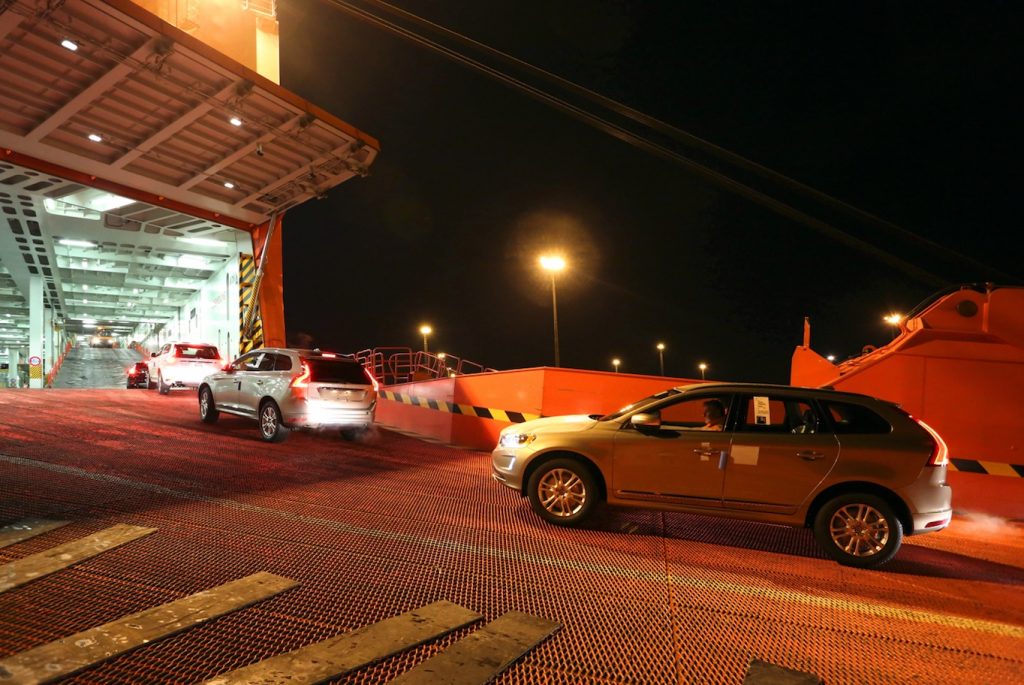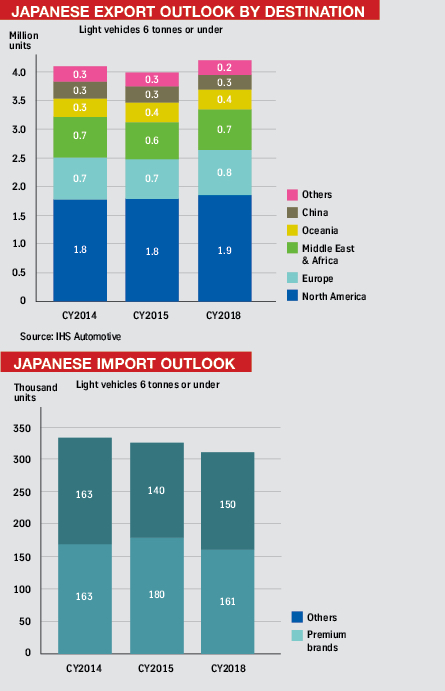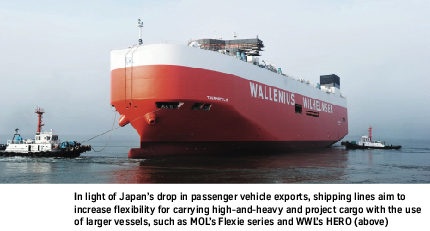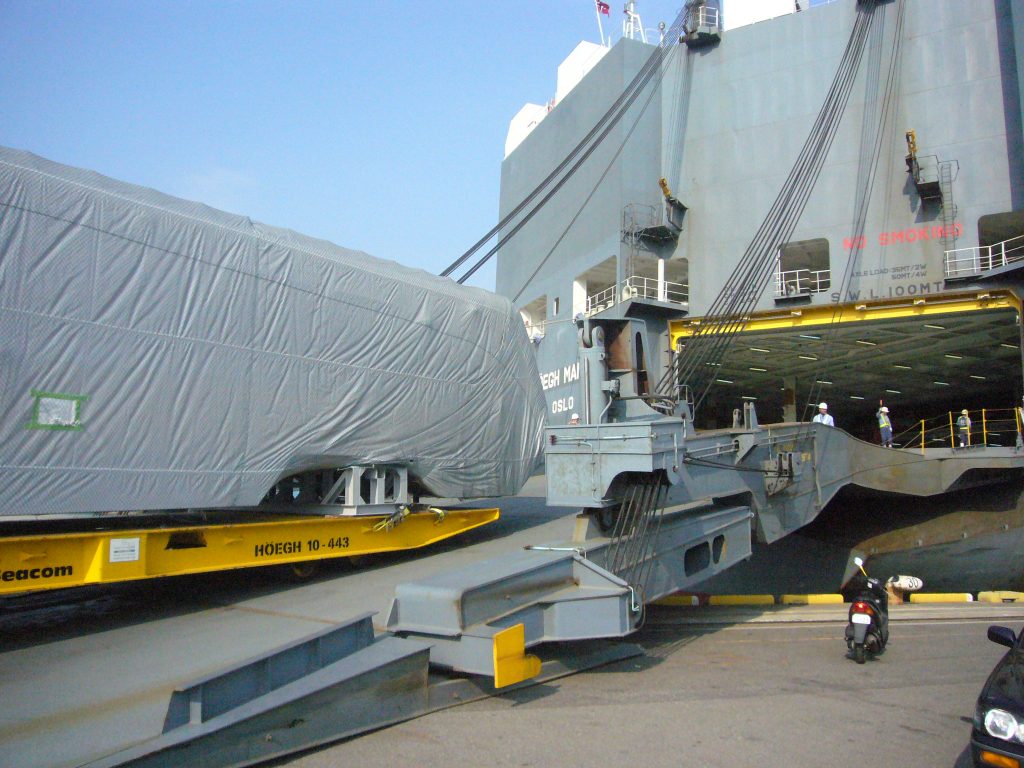 While it remains the top exporter of finished vehicles, Japan has shifted from its central role in the global vehicle trade, with shipping companies adjusting their strategies accordingly
While it remains the top exporter of finished vehicles, Japan has shifted from its central role in the global vehicle trade, with shipping companies adjusting their strategies accordingly
Japan has been the world’s top exporter of vehicles for decades, and it remains renowned for its quality of manufacturing as well as its efficient logistics processes. The country’s highly developed infrastructure and port network, as well as its dense concentration of shipping lines, support its status as an export giant. Meanwhile, Japanese carmakers’ global distribution networks have fostered growing sales in markets from Indonesia to the US to the Middle East.
However, Japanese manufacturing is experiencing significant demographic and economic changes. While the country still ranks as the world’s third largest vehicle producer, building more than 9.7m total vehicles in 2014, including 8.94m light vehicles, it has been in long-term decline; in 2007, total output was more than 11.5m units, including nearly 9.95m light vehicles, according to PwC Autofacts data. For 2015, production was on pace to decline at least 5-7% compared to 2014.
In this story...
Part of the decline is linked to Japan’s greying demographics; its ageing population is shrinking and is expected to fall further, taking down domestic sales with it. Over the past ten years, Japan’s light vehicle sales have fallen by around 10% in total, from 5.5m units per year to 5m. LMC Automotive forecasts that by 2025, light vehicle sales will fall further to around 4.1m units. Sales in 2015 have already been weak, down 8-10% compared to 2014.
Along with domestic change, Japan has been at the centre of a substantial shift in global automotive manufacturing. Its vehicle exports have fallen from peak levels of more than 6m light vehicles in 2007, to around 4m units expected in 2015. It is a number that may fall a bit more or flatten, according to Tsukasa Watanabe, lead analyst for Asia Pacific at PwC Autofacts.
While still a major player, Japan is now less central to the global trade of vehicles and shipping lines. Back in the 1990s and early 2000s, it accounted for around 90% or more of deep-sea vehicle exports. Today, the total is closer to 30% and shrinking.
Japan’s production and export decline began in many ways with the emergence of neighbouring South Korea two decades ago as a competitive exporter, and later other low-cost, regional players, such as Thailand, where Japan’s OEMs have a strong footprint. Over that time, Japanese brands have expanded their global manufacturing presence, including a significant push into major markets like the Americas, Europe and Asia.
Those localising trends have accelerated of late. Japanese carmakers have been spurred on in part by shifts in the yen against major currencies and by competitive forces in other markets; logistics costs and risks have also played their part, including the fallout from the Japanese earthquake in 2011, when carmakers lost millions of units of production. Most notably, Toyota, Honda, Nissan and Mazda have all added significant new production capacity in the US and Mexico.
Such shifts have been important, says Masatoshi Nishimoto, manager of Japan and Korea vehicle production forecasting at consulting firm IHS Automotive in Tokyo, especially since the US is Japan’s biggest export customer, accounting for 45% of its vehicle exports. Nissan currently exports more vehicles from its plants in Mexico than it does from Japan, with the great majority of Mexican-built vehicles going to the US. In 2008, Honda exported more than 400,000 units from Japan; in 2010, the level was still 300,000. For 2014, it exported just 30,000 units, with more than 95% of its demand in the US now satisfied by North American plants.
For shipping lines, trade flows have become more fractured across global and regional export flows. Toshifumi Inami, president of Wallenius Wilhelmsen Logistics (WWL) Japan, points out that the industry has seen export shipments once concentrated out of Japan spread out across Asia, including from markets like Thailand and Indonesia.
Rudolf Luttmann, director for car and ro-ro in Europe at Mitsui OSK Bulk Shipping (MOL), which has a fleet of around 120 pure-car-and-truck carriers (PCTCs), says that the response among shipping lines has been to increase port calls and combine Japanese cargo with other locations in Asia to fill vessels. MOL, for example, combines volume out of Japan with exports from Thailand, Malaysia, Indonesia, China, and India to fill up vessels, says Luttmann. He adds that MOL has also shifted some capacity from East Asia to cross-trade areas to minimise ballast voyages.
 MOL has also extended the frequency of its Asian network by working in partnership with Nissan Motor Car Carrier (NMCC) for feeder routes, a carrier in which it has a 40% stake. Luttmann says that cross trades within regions are the fastest growing services for MOL, including inter-Asian trade as well as trade from Mexico.
MOL has also extended the frequency of its Asian network by working in partnership with Nissan Motor Car Carrier (NMCC) for feeder routes, a carrier in which it has a 40% stake. Luttmann says that cross trades within regions are the fastest growing services for MOL, including inter-Asian trade as well as trade from Mexico.
The situation is similar for other shipping lines. “Höegh Autoliners is moving to more liner-oriented trades [from East Asia], rather than the nomination-based tramp services of the past,” says Per Drange Hansen, head of the East Asia region at the Norwegian shipping line.
WWL has also supported its East Asia trading network with calls at regional ports in South Korea, Singapore and Thailand, according to Toshifumi Inami. The shipping line combines services where sensible with its sister line, Eukor, which is the main carrier out of South Korea.
To further adjust their businesses in the region and beyond, MOL, Höegh and WWL, are investing in larger vessels that will expand capacity for high-and-heavy and project cargo, which they are targeting from Japan. Höegh’s new series of ‘Horizon’ vessels have significantly higher capacity for such cargo. WWL’s ‘HERO’ vessels have also increased capacity for high-and-heavy cargo. And MOL is adding four new ‘Flexie’ ships in 2017 and 2018, which have six liftable decks with adjustable heights to support larger-sized cargo.
Stability driven by North America
While manufacturing and export changes out of Japan are reshaping the business model for global PCTC carriers, the situation remains dynamic. For one thing, growth in the US market is benefitting Japanese brands and their Japanese plants. “The US vehicle environment has been dramatically changing for the better, amidst stagnating automotive demand in the global market,” says Masatoshi Nishimoto.
Nishimoto points to a number of factors supporting current levels of Japanese exports, notably healthy demand in the US, lower oil prices, and a weaker yen. The strength of the SUV segment in the US has been good for Japanese OEMs, which are competitive in the segment, he adds.
Although Japan’s carmakers build many of these models in North America, many of their local plants are operating at full capacity, encouraging imports from Japan. Nissan, for example, is allocating capacity at its plant in Kyushu in 2016 to build the Rogue crossover SUV, as it can’t build enough at its plant in Tennessee to maintain demand; it is also importing the model from a Renault plant in South Korea.
Honda, meanwhile, is increasing exports to the US of its Fit model from Japan. Though the vehicle is made at its new plant in Celaya, Mexico, the carmaker has said that plant will focus on the new HRV compact SUV. Toyota has shown a slight increase in Japanese exports to North America, while Subaru continues to grow Japanese exports substantially as its American sales rise faster than it can add capacity at its US plant. Mazda’s imports to the US, meanwhile, have also risen marginally in 2015 despite its new plant in Mexico, largely thanks to strong truck and SUV sales.
Inami at WWL points out that Mitsubishi Motors also recently closed its US manufacturing plant, which will mean more Japanese exports. “Thus, in 2015 and 2016, we are seeing a rise in exports from Japan,” Inami says.
Further out, the prospect of the Trans-Pacific Partnership (TPP) trade deal, which involves Japan and several Asian neighbours, together with North America and several Latin American countries, could boost Japanese exports to a number of its key markets. However, the outcome of the deal is far from guaranteed, as national governments must first ratify it.
 Overall, this evolving picture highlights the need for shipping lines out of Japan to remain flexible. After manufacturers were hurt by years of an historically high yen that reached ¥75 to the dollar in early 2012, the currency has fallen dramatically to around ¥120 to the dollar, partly from the effects of so-called ‘Abenomics’, the economic and monetary policies put in place by prime minister Shinzo Abe. The drop, which makes Japanese exports more profitable, is one reason carmakers are quicker to use spare capacity in their home market, even as they build up overseas plants.
Overall, this evolving picture highlights the need for shipping lines out of Japan to remain flexible. After manufacturers were hurt by years of an historically high yen that reached ¥75 to the dollar in early 2012, the currency has fallen dramatically to around ¥120 to the dollar, partly from the effects of so-called ‘Abenomics’, the economic and monetary policies put in place by prime minister Shinzo Abe. The drop, which makes Japanese exports more profitable, is one reason carmakers are quicker to use spare capacity in their home market, even as they build up overseas plants.
Correspondingly, shipping lines are upping or maintaining services. Höegh Autoliners increased sailings from Japan from about two-to-three per month to three-to-four sailings. In October, Höegh Autoliners also increased its Japan-Africa service from one departure to two per month. Like WWL, MOL has also seen a small increase in exports from Japan in 2015, says Luttmann.
However, industry experts suggest a weaker currency and continued US sales growth will not be enough to reverse Japan’s export losses. Nishimoto at IHS doesn’t expect significant growth for Japan’s exports; he predicts they will maintain their current level of 4m-4.2m units through 2018.
Höegh’s Hansen also believes that any recent lifts in trade are not the start of a long-term revival. “The increased competitiveness caused by the weakening of the yen seems to be too little, too late for most manufacturers because investments abroad have generally been made and production more or less permanently moved,” says Hansen. “Thus, the prospect for increased exports is minimal in the short-to-medium term, especially since many of Japan’s export markets are quite slow, except for North America.”
Hansen also points out that not all of the volume growth for Höegh’s recent increases in sailings from Japan has been for new vehicles; used-car and high-and-heavy exports are benefitting more directly from a weaker yen in some markets.
Besides North America, Japan’s exports to other regions have been relatively subdued. Another important market, the Middle East, remains volatile. While Japanese brands have performed reasonably well in recession-hit markets like Russia and Brazil, sales there are very weak. China, points out WWL’s Inami, is not a big a factor for Japanese vehicle exports since most volume is built locally in the country.
Inami points to stability in the trade WWL serves from Japan to Europe, including for Toyota, Mitsubishi, Honda, Mazda and Suzuki. He also points to potential for Australia, where Toyota will close its plant in 2017, creating import opportunities. In spring 2016, WWL will open a brand-new automotive terminal in the port of Melbourne, for example.
On the other hand, he says that the mining sector has been slow in Australia for the past few years, so WWL has seen fewer exports of high-and-heavy equipment from Europe and North America to the country.
Import possibilities
Japan’s import market, although relatively small, has seen some gains in recent years. Nishimoto at IHS points to an earlier stock market rally that prompted increases in higher end models, with German luxury brands particularly in demand. IHS Automotive expects that full-year 2015 import volume of light vehicles will be around 330,000 vehicles, a slight decline from 2014. This volume is about double what Japan imported in 2009 (although imports remain below their peak of around 440,000 in 1996).
Nishimoto says that foreign OEMs are expanding their product line-ups in Japan, with the number of import models on offer expected to rise from 219 in 2015, to 230 by 2018. However, the weak yen, together with a declining population and domestic vehicle market, will likely restrain overall import volume.
IHS forecasts that import volume will drop to around 310,000 by 2018, although imports will gain market share as domestic sales fall by even more. The TPP could eventually open the Japanese market further to foreign-built vehicles. However, foreign carmakers may be unlikely to penetrate the specialised kei segment of very small cars, which makes up a significant share of the Japanese local market.
On the import shipping side, WWL transports some vehicles from the US west coast to Japan, including Tesla Motors’ electric vehicles. Höegh Autoliners’ shipping from Europe to Japan has been stable in volume, says Hansen, while the carrier has also added a service from the US west coast back to Asia on its East Asia-South America return leg. However, Hansen suggests that imports to Japan will decline. “They are experiencing the opposite effect of exports, with foreign products becoming more expensive because of exchange rates,” he points out.
Overcoming defficiency
Japan is a critical market, but one with challenges at many turns. Its declining population will likely lead to further falls in vehicle sales and usage. The TPP may add dynamism to both its export and import markets, but few expect that overall production and volume will start climbing back toward prior highs.
The current trade patterns out of Japan, which absorb and combine volume across Asia, make it more difficult to run efficient vessel operations considering the higher number of port calls, says MOL’s Luttmann. WWL executives, including its CEO Chris Connor, have for years suggested that ro-ro shipping will have to shift further to ‘hub-and-spoke’ trade patterns to better manage costs and service across the fragmentation in shipping flows.

While Japan ranks highly for its logistics infrastructure, the country also faces deficits in its facilities and processes. At WWL, whose primary export ports in Japan are Nagoya, Gamagori, Yokohama, Hiroshima, Nakanoseki, Omaezaki and Toyohashi, Inami points to challenges. “Governmental restrictions are a challenge. Vessel berths have been a maximum length of 200 metres for some time and are still not budging,” he says. “The reason is that expansion takes time and money. While expansion is underway, the berth cannot be used, which is a problem.”
Still, Japan’s vehicle trade could see some stability in volume following a period of decline. While the long-term impacts of ongoing production growth in markets like the US and Mexico are still unknown, for now Japan’s carmakers and shipping lines are working flexibly to serve shifting global markets. Rudolf Luttmann says that Japan is still the centre of MOL’s network and this will not change completely. “To maintain and improve the service level is quite important, as customers require smaller lots with higher frequency service more and more,” he says. “The global network is becoming more important for logistics optimisation.”
Such focus will be crucial as the integration of Japan into a broader Asian vessel network becomes even more important, especially so if the TPP is ratified. Despite economic changes and other setbacks, Japan will remain a global leader in the finished vehicle trade for the foreseeable future, but one that will require shipping lines to adapt further still.
Contribution by Christopher Ludwig




































